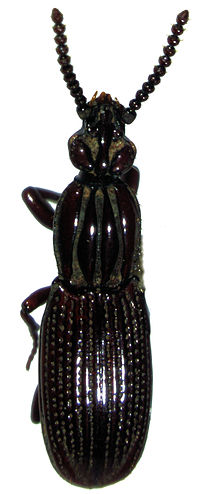Rhysodidae
| Wrinkled bark beetle | |
|---|---|

| |
| Kaveinga lusca | |
| Scientific classification | |
| Domain: | Eukaryota |
| Kingdom: | Animalia |
| Phylum: | Arthropoda |
| Class: | Insecta |
| Clade: | Coleopterida |
| Order: | Coleoptera |
| Suborder: | Adephaga |
| Family: | Rhysodidae Laporte, 1840 |
| Tribes | |
Rhysodidae (sometimes called wrinkled bark beetles) is a family of beetles, consisting of more than 350 species in about 20 genera.
These beetles are elongate, in size ranging from 5–8 mm, and color ranging from a reddish brown to black. Both the thorax and the elytra are deeply grooved lengthwise, thus giving these beetles their common name. The head is also grooved, and posteriorly constricted into a short but visible "neck". The 11-segment antennae are short, resembling a string of beads, while the mandibles lack cutting edges and are thus nonfunctional. The front legs are short and strongly built,
Adults and larvae live in moist rotten wood that is infested with slime moulds, which are believed to be their diet. Instead of using their mandibles to bite, they use the anterior edge of the mentum and swivel their heads to cut off pieces of food. Adults do not make burrows, instead just squeezing between the cell layers of the decomposed wood, generally leaving no visible trace of their passage, while larvae live in short tunnels.
They occur on all continents with forested areas, the richest fauna being found in New Guinea, Indonesia, the Philippines, and northern South America.
Classification remains controversial, with specialist Ross T. Bell arguing for placement as a tribe Rhysodini of Carabidae, while R. G. Beutel and others argue that larval characteristics indicate that rhysodids are their own family.[1] Recent DNA analysis supports the placement of Rhysodidae within the family Carabidae.[2]
The following genera have generally been treated as members of the family Rhysodidae, but are now sometimes considered members of Carabidae instead.
- Arrowina Bell & Bell, 1978 (Palearctic, Indomalaya)
- Clinidium Kirby 1835
- Dhysores Grouvelle 1903 (Africa)
- Grouvellina Bell & Bell 1978 (Madagascar, Comoros)
- Kaveinga Bell & Bell 1978 (Australasia)
- Kupeus Bell & Bell 1982 (New Zealand)
- Leoglymmius Bell & Bell, 1978 (Australia)
- Medisores Bell & Bell, 1987 (South Africa)
- Neodhysores Bell & Bell 1978 (South America)
- Omoglymmius Ganglbauer, 1891
- Plesioglymmius Bell & Bell, 1978
- Rhysodes Germar 1822 (Paleac)
- Rhyzodiastes Fairmaire 1895
- Shyrodes Grouvelle, 1903 (Indomalaya)
- Sloanoglymmius Bell & Bell, 1991 (Australia)
- Srimara Bell & Bell, 1978 (Vietnam)
- Tangarona Bell & Bell 1982 (New Zealand)
- Xhosores Bell & Bell, 1978 (South Africa)
- Yamatosa Bell & Bell, 1979
References
- ^ Bousquet, Yves (2012). "Catalogue of Geadephaga (Coleoptera, Adephaga) of America, north of Mexico". ZooKeys (245). Pensoft: 1–1722. doi:10.3897/zookeys.245.3416. PMC 3577090. PMID 23431087.
- ^ Mckenna, Duane D.; Wild, Alexander L.; Kanda, Kojun; Bellamy, Charles L.; et al. (2015). "The beetle tree of life reveals that Coleoptera survived end‐Permian mass extinction to diversify during the Cretaceous terrestrial revolution". Systematic Entomology. 40 (4): 835–880. doi:10.1111/syen.12132. hdl:10057/11540.
- Ross H. Arnett, Jr. and Michael C. Thomas, American Beetles (CRC Press, 2001)
- Rolf G. Beutel; Richard A. B. Leschen (2005). Handbuch der Zoologie - Coleoptera, Beetles, Volume 1: Morphology and Systematics (Archostemata, Adephaga, Myxophaga, Polyphaga partim) (in German) (1st ed.). de Gruyter. ISBN 3-11-017130-9.
External links
![]() Data related to Rhysodidae at Wikispecies
Data related to Rhysodidae at Wikispecies
